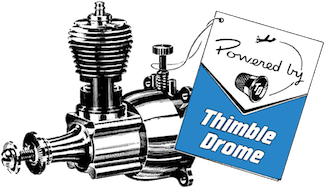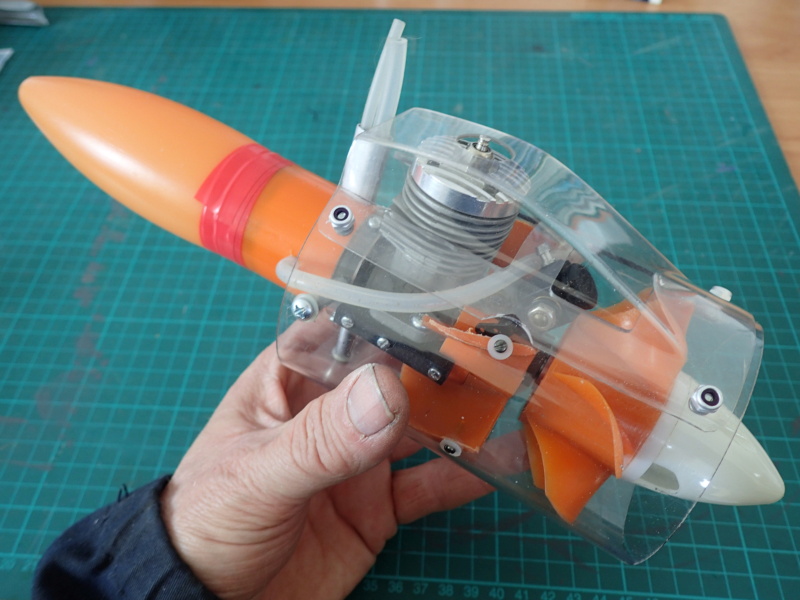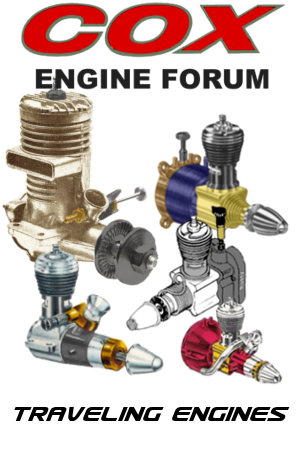Log in
Search
Latest topics
» How's the weather?by HalfaDave Today at 12:02 pm
» Cox .35 and .40 in Nürnberg Toy Fair
by Levent Suberk Today at 11:57 am
» Wen Mac .049 - Conditioning.
by MauricioB Today at 11:39 am
» music vids.. some of your favorites
by HalfaDave Today at 11:23 am
» Enya .09 II Questions
by Surfer_kris Today at 10:59 am
» Jim Walker Firebaby
by rsv1cox Today at 8:27 am
» Draco Goes Flying, But Misses the Eclipse
by HalfaDave Yesterday at 9:59 pm
» A prototype Cox Reed-valve marine engine
by davidll1984 Yesterday at 9:15 pm
» Happy 53rd birthday Mauricio!!!
by MauricioB Yesterday at 11:47 am
» Testers Sprite engine swap
by Greenman38633 Yesterday at 10:57 am
» UV Restore of Yellowed Decals
by Levent Suberk Yesterday at 8:59 am
» 22mm 2-blade nylon marine prop and solid-shaft drive
by roddie Yesterday at 6:46 am
Cox Engine of The Month
Propellor Performance Question
Page 1 of 1
 Propellor Performance Question
Propellor Performance Question
I understand propellor pitch, however, I do not understand the impact of propellor pitch and propellor size on engine performance and flight. Can anyone explain the advantage of using a larger prop as it pertains to flight performance? For example, if I were to use an engine swinging a 7X4 propellor at 1200 RPM how would my flight performance differ from the same engine swinging a 4X2 Propellor at 22K RPM? Does the larger prop and pitch provide more power to lift a heavier model? Thanks, Andy

anm2- Gold Member

- Posts : 292
Join date : 2013-03-30
 Re: Propellor Performance Question
Re: Propellor Performance Question
OK, you can visit the Master Airscrew site for more detail...
http://masterairscrew.com/
I'll try to be brief and hit the high points.
Pitch is the theoretical distance the propeller will travel if it doesn't slip in one complete revolution.
Diameter is measured to the circle the propeller tips theoretically trace out.
For a 2 blade propeller this is the length through the hub of the prop from tip to tip. For a 1 blade it is theoretical, and for more than 2 blades it is just harder to measure.
If you do some simple area math (geometry) on a propeller, you find that diameter increase will increase the circle of air that is moved. If a larger circle of air is moved the more thrust is generated, so a larger propeller may provide more thrust at a given RPM.
Pitch at a given RPM will translate to a theoretical maximum speed which the airplane will not exceed because once the propeller is traveling the pitch distance in the air it will resist moving faster, ie: farther per revolution than the pitch, per rpm.
With an IC engine diameter will change the RPM the engine operates at due to flywheel effects.
With an electric motor the motor/esc will attempt to maintain the set RPM. In a properly set up electric driveline the RPM on the ground will be the same as in the air at a given throttle setting.
Now a little mind blowing thought:
With small IC engines that operate at very high RPM reving the engine up with a small prop ends up producing more thrust than running a large prop. At a certain size (about .09?) the engine operating RPM is lower due to larger prop sizes SO increasing diameter will have less effect on RPM SO increasing diameter can dramatically increase thrust because the thrust lost to RPM loss is less than the thrust gained from more area swept per RPM.
This is a whole lot of not easy to wrap a brain around.
Phil
http://masterairscrew.com/
I'll try to be brief and hit the high points.
Pitch is the theoretical distance the propeller will travel if it doesn't slip in one complete revolution.
Diameter is measured to the circle the propeller tips theoretically trace out.
For a 2 blade propeller this is the length through the hub of the prop from tip to tip. For a 1 blade it is theoretical, and for more than 2 blades it is just harder to measure.
If you do some simple area math (geometry) on a propeller, you find that diameter increase will increase the circle of air that is moved. If a larger circle of air is moved the more thrust is generated, so a larger propeller may provide more thrust at a given RPM.
Pitch at a given RPM will translate to a theoretical maximum speed which the airplane will not exceed because once the propeller is traveling the pitch distance in the air it will resist moving faster, ie: farther per revolution than the pitch, per rpm.
With an IC engine diameter will change the RPM the engine operates at due to flywheel effects.
With an electric motor the motor/esc will attempt to maintain the set RPM. In a properly set up electric driveline the RPM on the ground will be the same as in the air at a given throttle setting.
Now a little mind blowing thought:
With small IC engines that operate at very high RPM reving the engine up with a small prop ends up producing more thrust than running a large prop. At a certain size (about .09?) the engine operating RPM is lower due to larger prop sizes SO increasing diameter will have less effect on RPM SO increasing diameter can dramatically increase thrust because the thrust lost to RPM loss is less than the thrust gained from more area swept per RPM.
This is a whole lot of not easy to wrap a brain around.
Phil

pkrankow- Top Poster

- Posts : 3025
Join date : 2012-10-02
Location : Ohio
 Re: Propellor Performance Question
Re: Propellor Performance Question
"With small IC engines that operate at very high RPM reving the engine up with a small prop ends up producing more thrust than running a large prop. At a certain size (about .09?) the engine operating RPM is lower due to larger prop sizes SO increasing diameter will have less effect on RPM SO increasing diameter can dramatically increase thrust because the thrust lost to RPM loss is less than the thrust gained from more area swept per RPM."
The response I pulled out in quotes gets to my question. So with an .049 engine, the RPM loss due to propellor size actually decreases thrust. So why would someone use an 8X4 propellor on a Texaco Engine? How would that be better than an 5X3 Propellor? I have actually read that a texaco engine with an 8X4 propellor only does about 9000 RPM or less. Are they doing that only to decrease fuel consumption? Thanks, Andy

anm2- Gold Member

- Posts : 292
Join date : 2013-03-30
 Re: Propellor Performance Question
Re: Propellor Performance Question
You're correct, the Texaco engines are slowed down to lower fuel consumption.
The guys have given you a good explanation of diameter vs pitch. Phil hit the nail on the head WRT to diameter. A quick calculation shows that a 5" prop has ~ 56% more disk area than a 4" prop; a 6" prop has 44% more disk area than a 5" prop and a 7" prop is 36% larger than a 6" prop. These percentages convert roughly to the volume of air being moved when comparing diameters.
The load imposed on an engine is significantly greater as we increase diameter, consequently to realize higher rpms, we either need to reduce the diameter for a given pitch or find a more powerful engine. That's on the pulling side.
The big killer is parasitic drag -- parasitic drag increases roughly with the square of the airspeed, so it takes more than twice as much power to go twice as fast. Conversely, a 6x4 turning 15K will not give twice the speed of a 6x2 @ 15K. To continue to drive your speed up, you'll need to find increasingly higher rpm and/or move to a larger diameter (to shove a greater volume of air) in order to overcome the the greater drag.
Static thrust measured on a stand will help with comparing props and engines, but without adjusting for drag, you cannot make a straight jump to aircraft performance.
The guys have given you a good explanation of diameter vs pitch. Phil hit the nail on the head WRT to diameter. A quick calculation shows that a 5" prop has ~ 56% more disk area than a 4" prop; a 6" prop has 44% more disk area than a 5" prop and a 7" prop is 36% larger than a 6" prop. These percentages convert roughly to the volume of air being moved when comparing diameters.
The load imposed on an engine is significantly greater as we increase diameter, consequently to realize higher rpms, we either need to reduce the diameter for a given pitch or find a more powerful engine. That's on the pulling side.
The big killer is parasitic drag -- parasitic drag increases roughly with the square of the airspeed, so it takes more than twice as much power to go twice as fast. Conversely, a 6x4 turning 15K will not give twice the speed of a 6x2 @ 15K. To continue to drive your speed up, you'll need to find increasingly higher rpm and/or move to a larger diameter (to shove a greater volume of air) in order to overcome the the greater drag.
Static thrust measured on a stand will help with comparing props and engines, but without adjusting for drag, you cannot make a straight jump to aircraft performance.
 Re: Propellor Performance Question
Re: Propellor Performance Question
Three greenies given out. To Phil and Andrew for compiling an eloquent answer that clearly explained it, and saving me from a brain hemorrhage while trying to come up with answers that wouldn't have been as elegantly to the point. Also for the comparison between the effects on an IC as compared to an electric. And a greenie to Andy for grasping the concepts right off the bat.
I boldly thought I knew so much about the effects of props from flying 1/2A. But when I started flying CLPS with bigger engines, not running at full scream, I was suddenly confused again and could predict nothing when trying different props, pitches and diameters. And have only recently(I'm slow on the uptake) realized the differences fixed RPM electrics offer.
Rusty
I boldly thought I knew so much about the effects of props from flying 1/2A. But when I started flying CLPS with bigger engines, not running at full scream, I was suddenly confused again and could predict nothing when trying different props, pitches and diameters. And have only recently(I'm slow on the uptake) realized the differences fixed RPM electrics offer.
Rusty
_________________
Don't Panic!
...and never Ever think about how good you are at something...
while you're doing it!
My Hot Rock & Blues Playlist
...and never Ever think about how good you are at something...
while you're doing it!
My Hot Rock & Blues Playlist

RknRusty- Rest In Peace

- Posts : 10869
Join date : 2011-08-10
Age : 68
Location : South Carolina, USA
 Re: Propellor Performance Question
Re: Propellor Performance Question
Thanks for everyone's response. The last question I have concerns .049 diesels. Is there an advantage to using a .049 diesel? Realizing that diesel provides greater torque allowing you to put a larger prop on the engine without the corresponding drop in RPM. Does it change the flight characteristics at all using a diesel with a large prop with less RPM vice a glow engine spinning a small prop at high RPM? This assumes that both are creating the same amount of thrust. Thanks, Andy

anm2- Gold Member

- Posts : 292
Join date : 2013-03-30
 Re: Propellor Performance Question
Re: Propellor Performance Question
Diesel is a more energy-dense fuel than alcohol, so when running at the proper RPM more torque is generates using less volume of fuel. Diesel also burns slower than alcohol so the peak of the power band is at a lower rpm.
While I have messed with diesel some, I have not had reliable performance.
Phil
While I have messed with diesel some, I have not had reliable performance.
Phil

pkrankow- Top Poster

- Posts : 3025
Join date : 2012-10-02
Location : Ohio
 Re: Propellor Performance Question
Re: Propellor Performance Question
"......Now a little mind blowing thought:
With small IC engines that operate at very high RPM reving the engine up with a small prop ends up producing more thrust than running a large prop. At a certain size (about .09?) the engine operating RPM is lower due to larger prop sizes SO increasing diameter will have less effect on RPM SO increasing diameter can dramatically increase thrust because the thrust lost to RPM loss is less than the thrust gained from more area swept per RPM.
This is a whole lot of not easy to wrap a brain around.
Phil"
If you want to achieve the highest flight speed you must select the propeller dia/pitch combination that allows the engine to run at its rpm where the highest engine output is generated. Too large dia/pitch prop will cause the engine to run below, too small dia/pitch prop will cause the engine to run above the rpm where the engine power is maximum.
Refer to the performance charts on this site (click on Performance on the left): http://www.mh-aerotools.de/airfoils/cox_frameset.htm
(The engine output required to pull a plane at a given speed is proportional to the third power of speed)
With small IC engines that operate at very high RPM reving the engine up with a small prop ends up producing more thrust than running a large prop. At a certain size (about .09?) the engine operating RPM is lower due to larger prop sizes SO increasing diameter will have less effect on RPM SO increasing diameter can dramatically increase thrust because the thrust lost to RPM loss is less than the thrust gained from more area swept per RPM.
This is a whole lot of not easy to wrap a brain around.
Phil"
If you want to achieve the highest flight speed you must select the propeller dia/pitch combination that allows the engine to run at its rpm where the highest engine output is generated. Too large dia/pitch prop will cause the engine to run below, too small dia/pitch prop will cause the engine to run above the rpm where the engine power is maximum.
Refer to the performance charts on this site (click on Performance on the left): http://www.mh-aerotools.de/airfoils/cox_frameset.htm
(The engine output required to pull a plane at a given speed is proportional to the third power of speed)

balogh- Top Poster



Posts : 4740
Join date : 2011-11-06
Age : 65
Location : Budapest Hungary
 Re: Propellor Performance Question
Re: Propellor Performance Question
Diesel engines are better in many aspects. You get a much higher thrust (at low speeds) compared to the high revving glow engines on small props. The reliability is much higher too, a good diesel engine never quits in the air, it may hit and miss but it rarely stops suddenly like a glow engine can do.
For a good reliability you need a good diesel engine of course. The "conversion heads" with teflon seals have nothing to do with the proper stuff.
The down side with diesels is that fuels are hard to come by, and the exhaust residue has a "scent" that only a mother can like...
For a good reliability you need a good diesel engine of course. The "conversion heads" with teflon seals have nothing to do with the proper stuff.
The down side with diesels is that fuels are hard to come by, and the exhaust residue has a "scent" that only a mother can like...

Surfer_kris- Diamond Member

- Posts : 1902
Join date : 2010-11-20
Location : Sweden
 Re: Propellor Performance Question
Re: Propellor Performance Question
When a diesel is set up correctly, PAWs in particular, Oliver Tigers (very expensive) - they are first flick starters and very, very reliable. I have used these in combat, team race and stunt. (Many years ago)
However, they are not very flexible with RC throttles. Works but not as wide ranging or responsive as a glow.
The fuel smells wonderful - the oily residue lingers on your clothes for days - a constant reminder.
Persistante extraordinairement parfum - l'un des plus agréables odeurs dans le monde!
There is a knack to getting it right and making the most of the relationship between the needle valve and the compression screw. The settings for cold starting and running when warmed up are different.
However, they are not very flexible with RC throttles. Works but not as wide ranging or responsive as a glow.
The fuel smells wonderful - the oily residue lingers on your clothes for days - a constant reminder.
Persistante extraordinairement parfum - l'un des plus agréables odeurs dans le monde!
There is a knack to getting it right and making the most of the relationship between the needle valve and the compression screw. The settings for cold starting and running when warmed up are different.

ian1954- Diamond Member

- Posts : 2688
Join date : 2011-11-16
Age : 69
Location : England
 Similar topics
Similar topics» Cox Propellor
» 1/4A-1/2A propellor mounting food for thought.
» Fashion model walks into spinning propellor
» A Question?.
» MY first post: .010 or .020
» 1/4A-1/2A propellor mounting food for thought.
» Fashion model walks into spinning propellor
» A Question?.
» MY first post: .010 or .020
Page 1 of 1
Permissions in this forum:
You cannot reply to topics in this forum

 Rules
Rules







